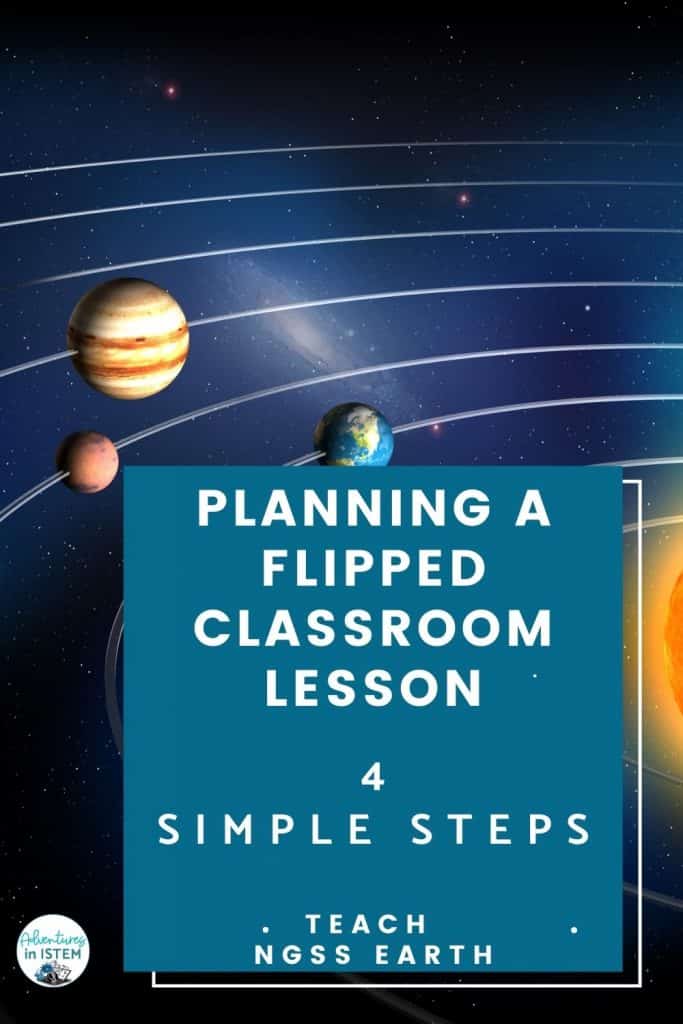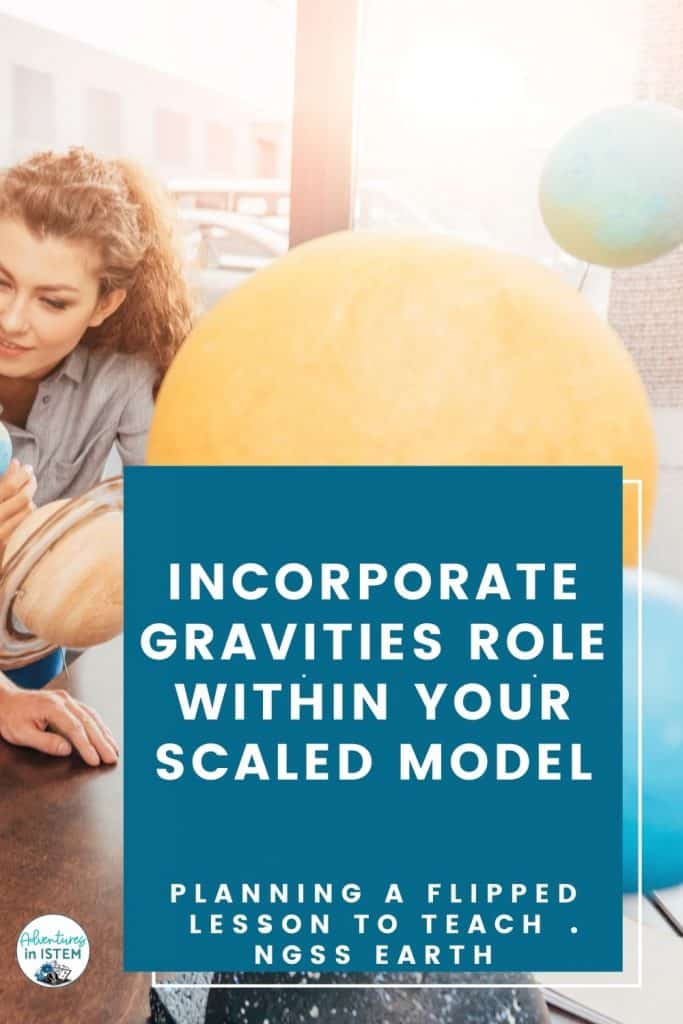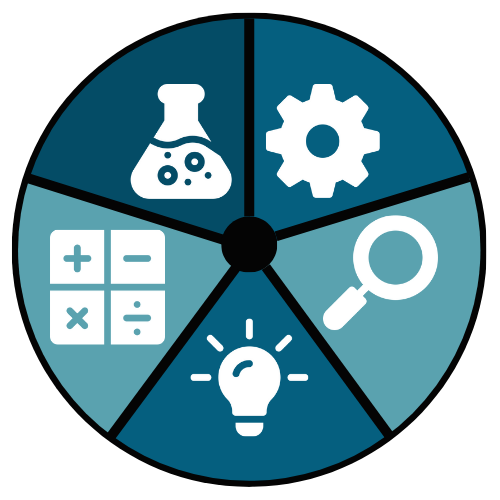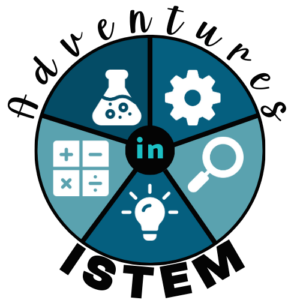Planning your flipped classroom lesson doesn’t have to be challenging. I’ve broken up the process for you into four simple steps to demonstrate how I flipped my solar system unit.

Teaching the solar system is one of my favorite topics to teach. There is so much information out there, and we are continuously learning more information about our planets every day. When I first started teaching it, Jupiter had the most planetary satellites with around 60. Now Saturn has the most planetary satellites, around 82, and Jupiter now has 79. Who knows what the numbers will be five years from now? The NGSS standard for this unit says the students will “Develop and use a model to describe the role of gravity in the motions within galaxies and the solar system” and “Analyze and interpret data to determine scale properties of objects in the solar system.” Notice that it is based on gravity’s role and influence on the solar system and the size of the different objects and not about the particular details of the objects. I like to bring standards MS-ESS1-2 and MS-ESS1-3 together when teaching about the solar system because I think they work perfectly together and lend themselves to high-level discussions.
The first step in planning your flipped classroom lesson is using your standard to plan out the unit.
The first thing I do when I’m planning out my flipped lesson looks at the standards. The standards show me my endpoint of where I need to get the students. I then plan backward to figure out what some basic concepts they will need to know to get them there are? What are some activities they will need to do and discussions we will need to have? Finally, How do I want students to demonstrate their understanding and application of the standard?
Students will need to understand what gravity is and how it works beyond just keeping us on Earth for these two standards. They will also need to know some basic details of the planets and other objects in our solar system. I will want to have them do some activities that deal with gravity and how distance and size can impact an object’s gravitational pull. I will also want them to do some comparison activities to make some scaled models using different objects. Finally, I will want to have some deep conversations about the difference between the size of the planets, comparing the inner planets to the outer planets and gravities role on the sizes, the number of planetary satellites, and the difference between a planets orbit and the orbit of a comet. Ultimately I would like my students to analyze and use data to create a scaled model of the solar system that includes the motion of the objects in the solar system and explains why they move the way they move and gravities’ role.
The second step in planning your flipped classroom lesson is deciding what you will flip and how you will flip.
Now that you have a basic idea of what you will do during the unit and what your students need, it is time to decide which information you will have the students learn at home. For me, this is anything that I would need to lecture on or give some basic information on. These are the basic concepts that they need to know to do the activities and have deeper discussions. I broke this unit up into four flipped lessons. Instead of giving them a video on all of the solar system planets, I broke it up, focusing on the inner planets with one video and the outer planets with a second video. By grouping the planets into the two groups, we could discuss why the groups have certain similarities and what might be causing those similarities. I also gave a video on the other objects in the solar system, which explained what they were and why dwarf planets were not considered planets. The video touched a little on the influence of gravity creating the shapes of those objects. Finally, I gave a video on gravity with some basic information about the amount of gravity an object has.
The third step in planning your flipped classroom lesson is determining how you want your students to engage with the flipped lesson and reflect on their learning.
Now that you know how many videos you will need to create or find and what information they will contain, it’s time to decide how you want your students to engage with the lesson. I usually use the same format for all of my flipped lessons to get used to the routine of what is expected.
For each flipped lesson video, I have them watch they are required to take Cornell Notes. I host my videos on Edpuzzle, which allows me to add comments and questions during the video. Before watching the video, it will prompt them to set up their Cornell notes with the topic and essential questions to guide their note-taking process. I feel that it is important to teach students how to take notes from videos so that they can do it on their own by the end of the year. For videos they watch at the beginning of the year, I will stop them every 45-90 seconds and prompt them with what key details should be included in their notes. As we move forward, I still stop them every 45-90 seconds, but now the prompt is to write the key details from the segment. By the end of the year, there is no stopping or prompting because I want them to pause the video on their own.
I also will ask them some check for understanding questions during the videos keeping them true/false and multiple choice. I love how I can see the analytics in Edpuzzle to let me know if there is a particular question that many students missed, how many times they watch a segment, and how long it took them to watch the video. I also love how the students know right away if they missed a question to go back then and rewatch the segment.
Finally, after watching the video, I have them take a short multiple-choice quiz with no more than 10 questions. All of the questions are basic questions that they should answer if they watched the video and took notes. I even allow them to use their notes for the quiz because they are at home, and I can’t control whether they use their notes or not. Using the Edpuzzle information and the quiz information lets me easily know which students are ready to move forward and which students are still struggling with the information.
The last step in planning your flipped classroom lesson is figuring out how to maximize your in-class time with your students best.

The beauty of the flipped classroom model is the opportunity to move your students to the higher level of Bloom’s taxonomy. You are no longer giving them the basic information in class. Instead, you are helping students take the basic information they learned from the flipped video and now apply, analyze, create, and evaluate. You can now have discussed why the inner planets have similar characteristics, why the outer planets have similar characteristics, and why they differ. Students could be researching and analyzing more information to support their hypothesis on what is causing the similarities and differences. They could do an online simulation to look at what happens when you increase or decrease the size of a star or planet and how gravity is affected. PhET has a great online simulation that allows students to do that called “Gravity and Orbits.” You could have them practice creating a scaled solar system model using circular objects like pebbles, fruit, beach balls or mapping out the solar system using Google Maps. They could discuss and compare each other’s models and check each other’s models for accuracy. You could have discussions about why Jupiter is the largest and what prevented it from becoming a star. You could have students choose a project to work on and choose to work in groups, pairs, or independently. The possibilities are endless.
The best part is that they are doing this high-level thinking with the support of you and other students together and not on their own at home, where they might become frustrated.





